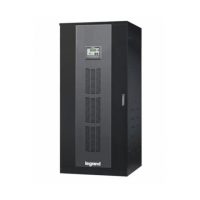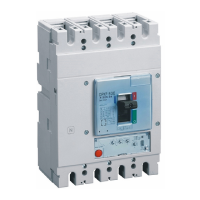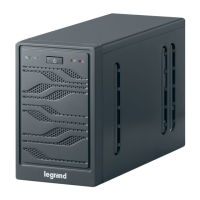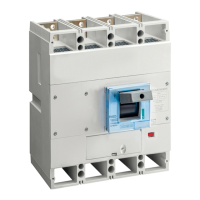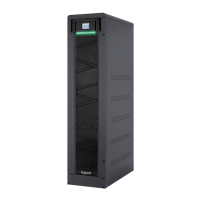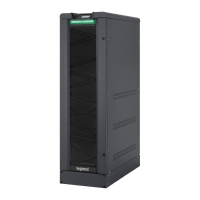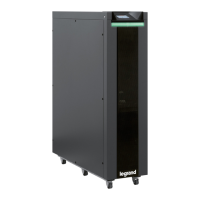
Do you have a question about the LEGRAND KEOR T EVO and is the answer not in the manual?
| Technology | On-Line Double Conversion |
|---|---|
| Input Voltage | 230 V (Single-Phase) |
| Output Voltage | 230 V (Single-Phase) |
| Battery Type | Valve Regulated Lead Acid (VRLA) |
| Form Factor | Tower |
| Protection Features | Overload, Short Circuit, Overvoltage, Undervoltage, Battery Deep Discharge |
| Frequency | 50/60 Hz (Auto-Sensing) |
| Maximum Current | Varies by model (consult datasheet) |
| Number of Outlets | Varies by model (consult datasheet) |
| Mounting | Floor Standing (Tower) |
| Operating Temperature | 0°C to +40°C |
| Storage Temperature | -15°C to +50°C |
| Humidity | 0-95% non-condensing |
| Standards | EN 62040-1, EN 62040-2, IEC 62040-3 |
| Dimensions | Varies by model (consult datasheet) |
| Weight | Varies by model (consult datasheet) |
Introduction to LEGRAND UPS KEOR T EVO product features and benefits.
Purpose and target audience of the installation and operation manual.
Defines warranty coverage based on General Conditions of Sale and Delivery.
Conditions under which the warranty does not apply and exclusions.
Explanation of safety symbols found on UPS labels (Protective Earth, High Voltage).
Specifies essential personal protective equipment for safe installation and maintenance.
Critical safety instructions for UPS installation, operation, and environmental conditions.
Safety precautions and handling guidelines for UPS batteries.
First aid and fire prevention measures for emergency situations.
Describes the UPS operation mode where the load is supplied by the inverter.
Explains the UPS operation mode when energy is drawn from batteries via the inverter.
Details the mode where UPS transfers loads automatically to mains voltage.
Describes Eco Mode for increased efficiency and energy saving, with reduced protection.
Mode used for settings via Front Panel or Service Software.
Procedure for isolating UPS circuitry while maintaining load operation.
Using an external bypass panel for isolation during maintenance.
Guidelines for safely transporting the UPS unit.
Safety requirements and recommendations for installing the UPS in its operational location.
Recommendations for storing the UPS and its batteries.
Electrical requirements, protection devices, and cable cross-sections for installation.
Details the different UPS models, their dimensions, and internal battery types.
Step-by-step instructions for safely unpacking the UPS unit.
General procedures and critical instructions for installing the UPS.
Detailed guide for making power connections for a single UPS unit.
Instructions for correctly grounding the UPS unit.
Procedure for connecting the main AC power supply to the UPS rectifier.
Steps for connecting the auxiliary AC power supply to the UPS.
Detailed instructions for connecting the UPS batteries, including safety warnings.
Instructions and safety precautions for connecting external battery cabinets.
Procedure for connecting the output power cables from the UPS.
Instructions for connecting multiple UPS units in parallel for increased power or redundancy.
Description of the front panel components: Touchscreen and LED Bar.
Detailed explanation of the touchscreen interface and energy flow diagram symbols.
Information provided by the status LED bar on the front panel.
Accessing sub-menus like Alarms, Measurements, Settings, Diagnostics, About, Commands.
Details on how to view and acknowledge UPS alarms.
Allows customization of UPS usage settings via password entry.
Provides detailed UPS and load measurements accessible via the menu.
Displays logged events and notifications, accessible via menu.
Provides information about the UPS model, serial number, and firmware versions.
Allows sending commands to the UPS after password entry.
Overview of standard and optional interface cards for UPS communication.
Details on connecting the UPS via RS232 for monitoring and control.
Configuration for remote switching and generator input supply.
Description and function of the 4 dry contact sockets on the interface board.
RS485 with Modbus protocol for industrial process monitoring and BMS.
Steps to prepare the UPS for operation, including battery fuse installation.
Procedures for starting up and commissioning the UPS.
Step-by-step guide to start the UPS using its internal battery.
Step-by-step guide to start the UPS using an external battery.
Instructions for safely shutting down and removing the UPS from service.
Procedure for transferring load to maintenance bypass without interruption.
Procedure for returning load from maintenance bypass back to UPS operation.
Overview of KEOR T EVO UPS systems for parallel configuration.
Explanation of N+1 and N+2 redundancy modes in parallel systems.
Using parallel mode to increase total system capacity.
Steps to commission and start multiple UPS units in parallel.
Instructions for decommissioning parallel UPS systems, with and without bypass.
Troubleshooting steps for bypass voltage failure alarms.
Diagnosing and resolving bypass phase sequence errors.
Troubleshooting inverter synchronization issues with bypass.
Diagnosing and resolving input phase sequence errors.
Troubleshooting rectifier synchronization with input power.
Diagnosing DC bus voltage failures.
Troubleshooting ESD (Emergency Switching Device) activation alarms.
Addressing high ambient temperature alarms.
Resolving overload alarms on the UPS output.
Troubleshooting alarms related to maintenance bypass activation.
Diagnosing and resolving battery test failure alarms.
Troubleshooting input voltage failure alarms.
Diagnosing high temperature alarms for inverter and rectifier.
Guidelines for battery maintenance, replacement, and safety.
Information on replacing battery fuses and associated risks.
Information on fan maintenance and replacement.
Information on capacitor maintenance and replacement.
